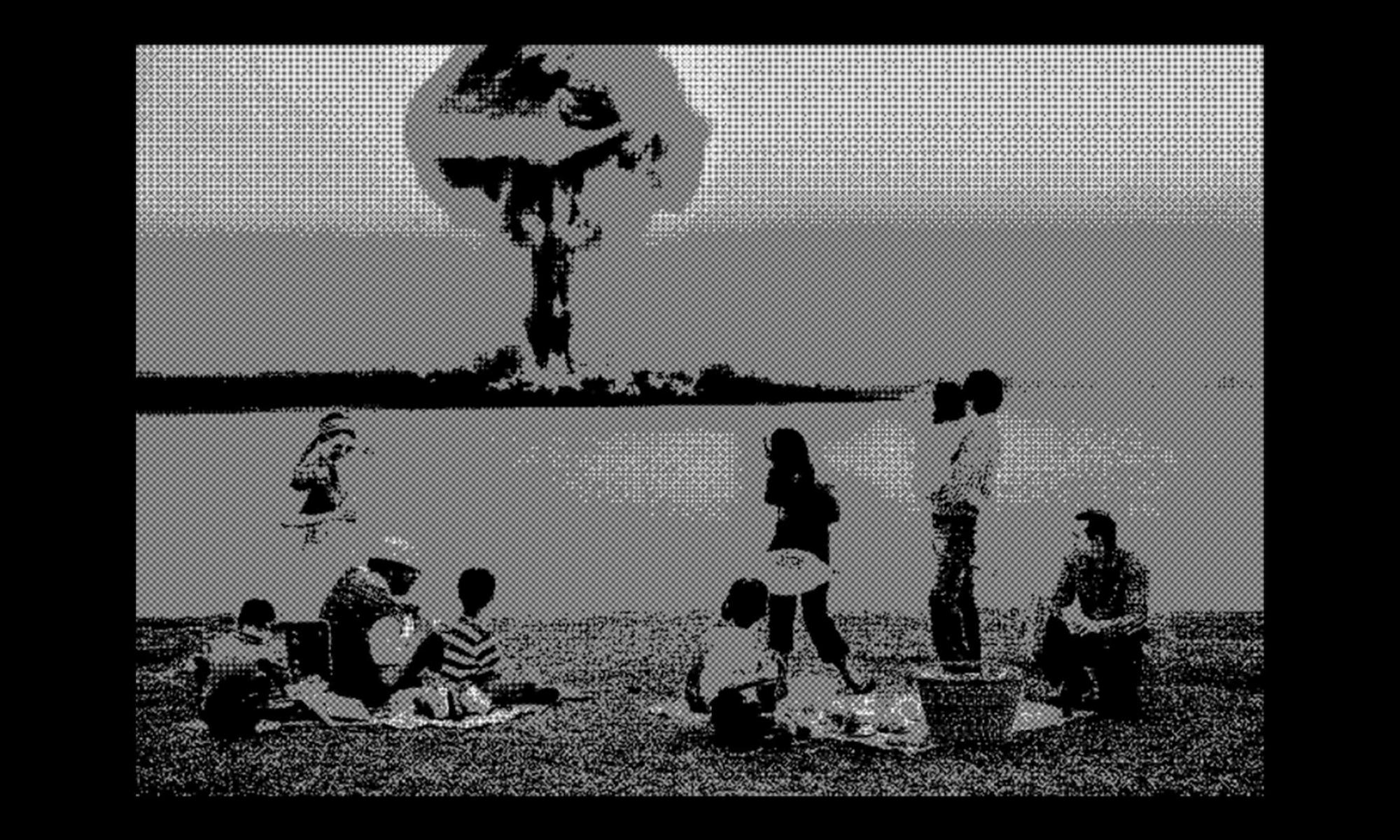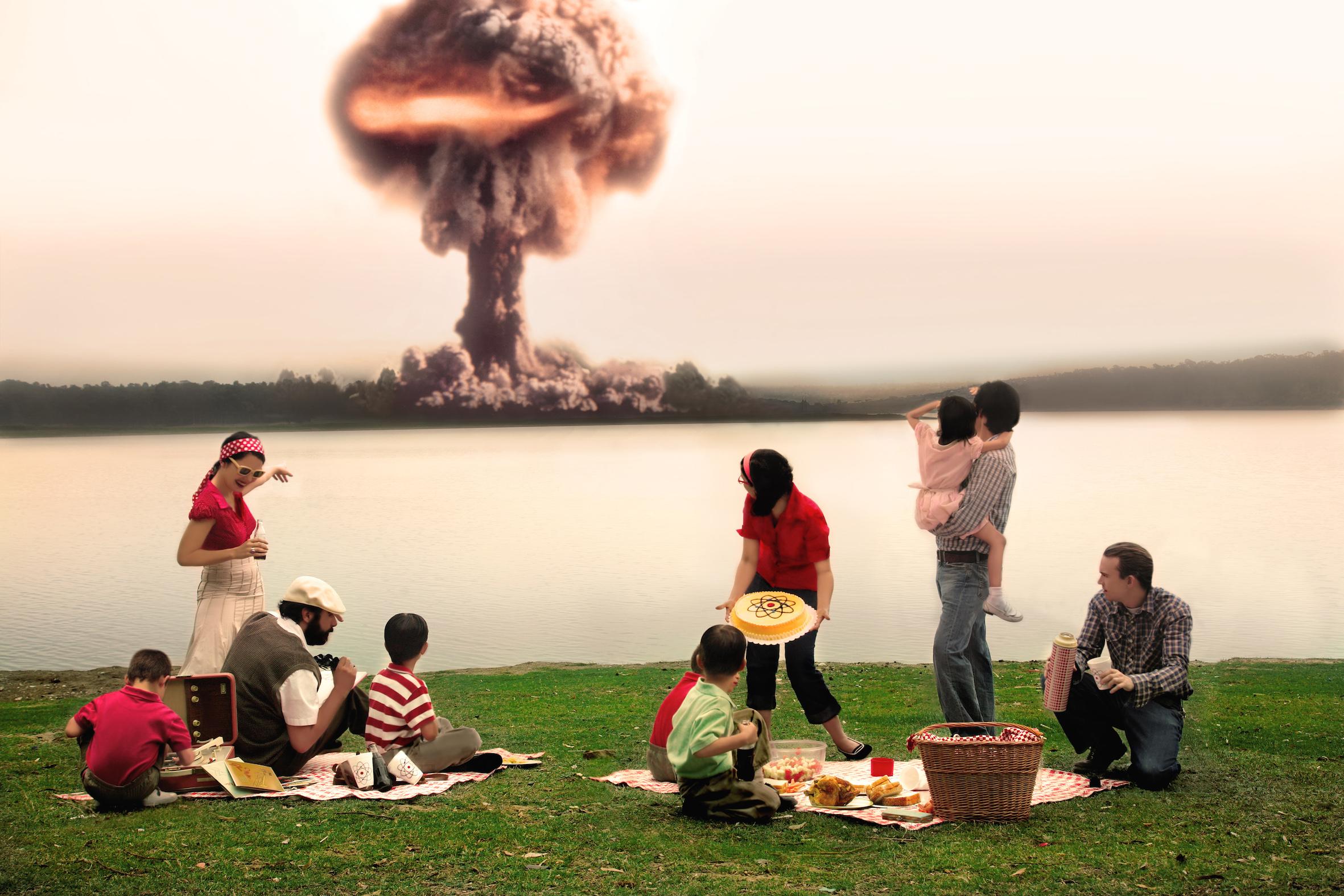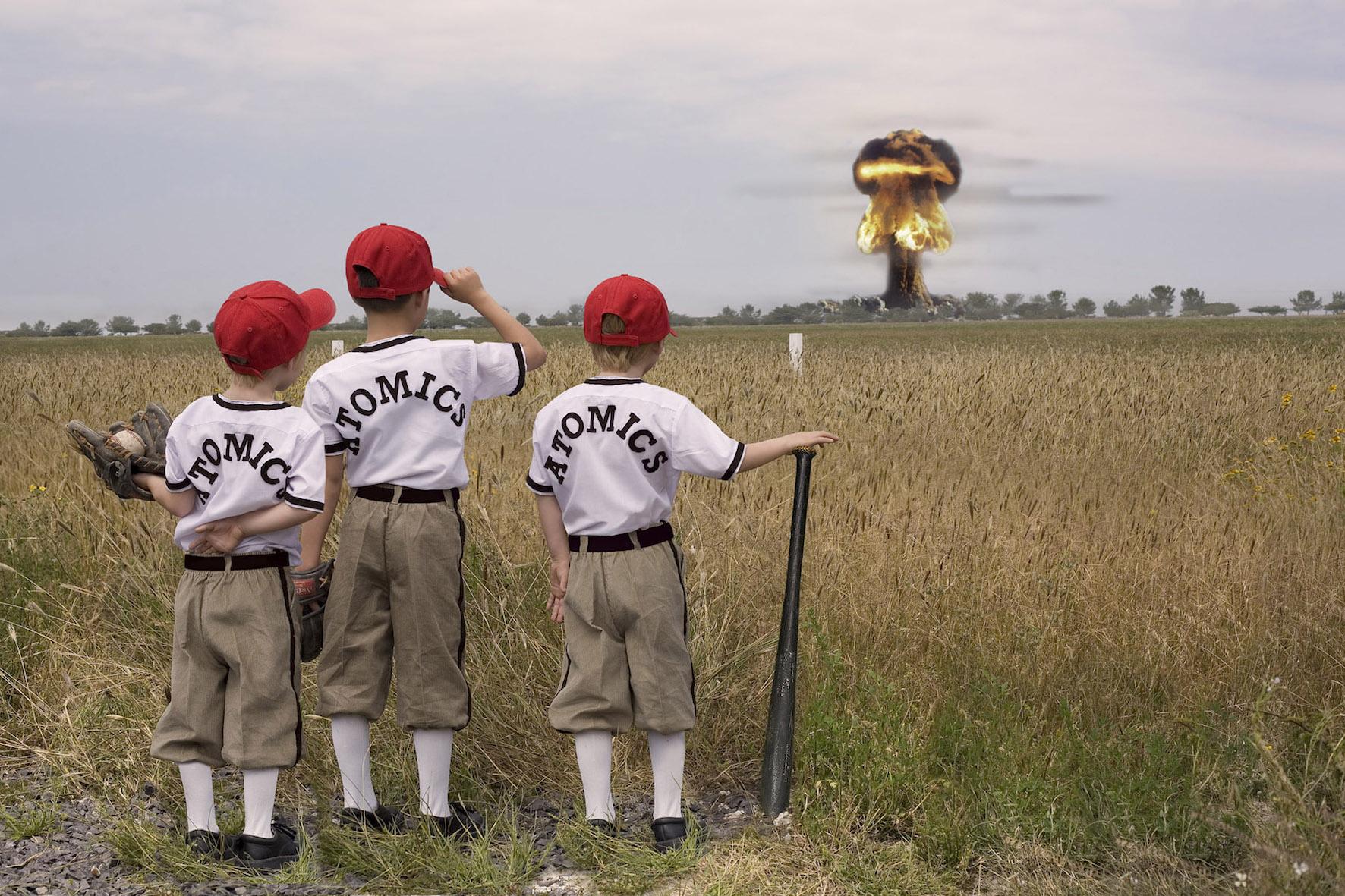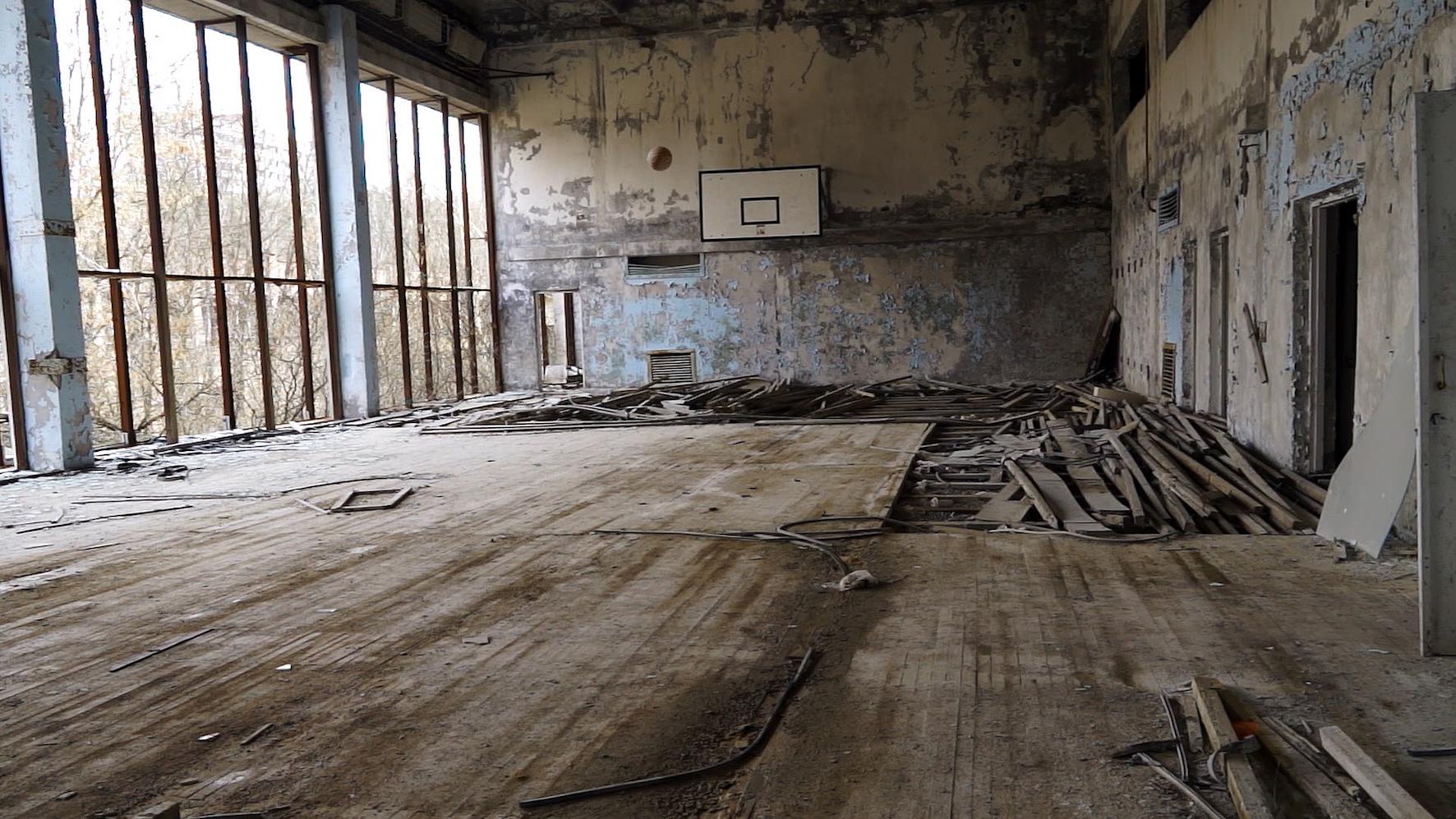Releasing Power: Atoms and Art
I. Hiroshima and Nagasaki
The Chilean poet Óscar Hahn includes in his poem Vision of Hiroshima as epigraph, a fragment of the ancient Sanskrit text Mamsala Purva: ‘... cast down upon the triple city a single projectile, loaded with the power of the universe.’ [1] These words introduce the poet’s version of an apocalyptic portrait of pain:
Look out for the bomb’s numerous eye,
unleashed under the burning mushroom.
Beware of the brilliance of unseeing Man, beware
The old people fled, beheaded by the fire,
angles impaled themselves on sulphuric horns,
beheaded by the fire,
virgins in their radioactive halos ran aground,
beheaded by the fire.
All the children migrated, beheaded by the sky.
It was not the maimed eye, nor the shrivelled skin nor the blood
spilled in the streets we saw:
it was coupling lovers taken by surprise,
turned to stone by hell’s incendiary,
lovers immobilised on the thoroughfare,
and Lot’s wife
turned to a pillar of uranium. [2]
By referencing two ancient texts —the Bible and the Sanskrit text— Hahn reveals a gory fragment in which temporalities disclose a destructive nature coming into play. In his poem, the word ‘vision’ comprises two meanings: the ability to see into both the past and present, and the wisdom to foresee the future. There is contradiction for the all-powerful gaze: one eye sees everything, and the other does not want to see, alluding to blindness and its dire progressivism.
As noted by Mexican poet and Nobel Prize recipient Octavio Paz, in a text written in 1986, which still resonates today:
‘There are so many ways by which the future has been discredited that it is impossible to list them all: some foresee the depletion of our natural resources, others the contamination of the planet, others the spread of famine, others the petrification of history by the universal establishment of totalitarian ideocracies, others the nuclear holocaust. More than half a century after, it is evident that nuclear deterrence has kept us from a Third World War, but for how long? At the same time, even if we succeed in avoiding catastrophe, the mere existence of atomic weapons literally sabotages the very idea of progress, whether as gradual evolution or as a revolutionary leap. Even if the nuclear belligerent capacity has not yet destroyed the world, it has destroyed our idea of the future. Modernity has suffered a fatal wound; the sun of progress has set on the horizon and we still cannot see the new intellectual star that will guide us. We do not know if we are living in a twilight or a dawn.’ [3]
The power of the atomic bomb surpassed the most ardent imagination, putting into question the notion of human annihilation as the by-product to technological development. In his poem ‘Atomic Bomb II’, the Brazilian poet Vinícius de Moraes claims:
carnivorous mineral lily,
radius radical rose.
Never again, oh atomic bomb,
Never, at any time, never
It is necessary that you kill [4]
Despite the unspeakable pain these radioactive blossoms produce, the sowing of these seeds of death has not stopped.
II. Mushroom Clouds
After sergeant George Caron, the tail gunner in the Enola Gay, photographed the atomic cloud that rose over Hiroshima on August 6, 1945, he declared: ‘The mushroom cloud itself was a spectacular sight—a bubbling mass of purple-gray smoke, and you could see it had a red core in it and everything was burning inside… It looked like lava or molasses covering a whole city.’ [5] Caron’s narration is testament to the great disconnection between those who drop the bomb and observe it from a distance, far from danger, and those who, in turn, suffer its direct effects.
Atomic clouds have a unique shape made up of gases, debris, smoke and condensed water vapor. The blossoming of these structures continues, with the multiple nuclear testings carried out in the Pacific between 1946 and 1962, in the Australian deserts between 1952 and 1956 and more recently in North Korea’s nuclear missiles underground facilities. The size, shape and power of these mushroom clouds make them unique visual objects that various artists (Salvador Dalí, Andy Warhol, Cia Guo-Qiang, among others) have included in their works from the late 1940s until the present day. Bruce Conner is one of the artists who best captures the realistic horrifying beauty of mushroom clouds in his thirty-seven-minute film Crossroads (1976), which consists of 27 slow-motion shots of the underwater nuclear bomb test at Bikini Atoll on July 25, 1946.
As part of her reflections on the tensions of the natural and the artificial, Mexican artist Daniela Edburg, in her series Killing Time (2008), creates fictional scenarios in which she captures the spectacularisation of mushroom clouds and the state of denial that surrounds nuclear weapons. In her work Atomic Picnic, a family sits and rests comfortably in a garden facing the sea. With tablecloths, blankets, baskets, plenty of food and music appearing to play from a portable turntable, she images a perfect picnic scene. A mother holds a cake that is decorated with an atom diagram while carefully observing the distance, along her husband and daughter. A woman with sunglasses points with her hand in the same direction. They seem happy and calm, as if what they are observing is not an atomic mushroom but rather a cinematic firework display. Similarly, The Atomics depicts a group of three blond boys, dressed in their Atomic club baseball uniforms, watching an explosion over what it looks as a deserted field, and Killing Time, which lends the series title, shows a woman in a rocking chair in a green field knitting a grey atomic bomb.
In this series, Edburg explores the idea of ‘killing time’ and ‘time to kill’, alongside that which is between what is seen and what might better remain hidden. “The project reflects on destruction as a characteristic of human nature,” Daniela says, “on what I like to call the Frankenstein phenomenon: when what we create turns around to destroy us.” [6] Frankenstein’s connection to the nuclear weapons could not be more precise, as both in the novel and in the case of nuclear power, it is human hubris which leads to the creation of a monster. Just as Victor Frankenstein denied for many years the existence and consequences of his creation, both governments and energy industries for decades have attempted to deny or minimise the harmful effects of atomic weapons and nuclear energy, which has, in turn, allowed their expansion worldwide. [7]
Concerned by weaponry availability, Mexican artist Pedro Reyes since 2008, has collected thousands of firearms in order to transform them into shovels for planting trees (Palas por Pistolas, 2008) or into instruments for playing music (Disarm, 2013). In February this year, the artist unveiled Amnesia Atómica (2020), a colossal mushroom-cloud-shaped inflatable sculpture, presented alongside a strong Nohbords dance performance featuring costumes printed with anti-nuclear messages, designed by Carla Fernández. The launch of the nine-meter-high coincided with the 53rd commemoration of the Treaty of Tlatelolco, a historic international agreement created during the Cold War, in response to the Cuban Missile Crisis of 1962. The agreement, signed in 1967, was a great achievement and a model for future treaties, being the first to declare a vast populated region, such as Latin America and the Caribbean, as a nuclear-weapon-free zone. The treaty was promoted by the Mexican diplomat Alfonso García Robles, whose effort earned him the Nobel Peace Prize in 1982. Reyes’ sculpture will itinerate around the world to raise awareness on the nuclear threat. And while the inflatable is too light-hearted and fails to convey a clear message of risk or tension by itself, Amnesia Atómica has noble intentions in wanting to draw attention to the nuclear issue and in memorialising an important treaty that was the first to ban such weapons throughout a large and densely populated region.
III. Chernobyl
In April 26, 1986, what is considered the most dramatic technological disaster of the 20th century occurred at Chernobyl. More than thirty years have passed since this tragic day, its consequences are still present, will be perpetually and are part of the daily lives for people living in Ukraine, Belarus and Russia. I remember moments when the ghost of Chernobyl was deeply present during the three years I lived in Moscow. One moment in particular, occurred in August 2010, when hundreds of wildfires broke out across Russia associated with high-record temperatures and climate change. The fires raised fears of increased radiation in many areas of the country and also the concern that winds would carry radioactive waste towards Moscow. [8] Some forest fumes reached Moscow, staining the Red Square with a strange pink mist creating a stifling and apocalyptic atmosphere. While they were not radioactive, they did have very high levels of toxic carbon monoxide. Following that incident, a few months later, to my surprise, I read in the news that the government of Ukraine officially announced the opening of Chernobyl as a tourist site. [9] What began as small private groups of tourists with a taste for the extreme, a decade later, after the release of the Chernobyl miniseries, tourist numbers peaked with more than 100,000 annual visitors. Close to 135,000 people were evacuated from the 19-mile exclusion zone around Chernobyl. Currently, Chernobyl, along with Pompeii, Auschwitz, Cu Chi tunnels, Bikini Atoll, etc., is on the list of dark tourism, evidencing the strange force that drives humans to visit former disaster sites.
Chernobyl has been the source of inspiration for several books, films and documentaries, and it has also inspired visual artists to create works. Among those are a few Australians, such as Guido Van Helten, who created, on the 30th anniversary of the disaster a graffiti on reactor 5, inspired by an image captured by photojournalist Igor Kostin on the day of the accident. Sydney-based artist Merilyn Fairskye, as part of her work on world atomic landscapes and sites created Plant Life (Chernobyl) (2010). [10] This series of photographs depicts views of a desolate, abandoned Chernobyl in the middle of winter, long before it became a known tourist destination.
Raul Ortega Ayala, teaser from The Zone, from the series From the Pit of Et Cetera, 2013-20.
In collaboration with Dmytro Konovalov, Valerii Savytskyi, Roberto Rubalcava, Dmytro Tiazhlov, Iain Frengley, Phil Burton and Tim Prebble. Single channel HD video, 36’ 37”.
Courtesy of the artist
With interests in historical detritus, collective memory and social amnesia, the Mexican New Zealand-based artist Raul Ortega Ayala has created a series of large-scale photographs and a beautiful film which capture the Chernobyl Exclusion Zone. The works are the result of several visits to the ghost city of Pripyat between 2013 and 2017. The Zone (2013-20) is a thirty-six-minute film that traces the story of four people that lived or worked in the nuclear city: the vice mayor of Pripyat; a fitness trainer who had hundreds of kids under his care when the accident happened; a man who was a boy at the time of the accident; and a woman who had a nine-month-old baby. Like the other 50,000 inhabitants of the city, their life changed in less than a day, and were forced to migrate leaving all behind. Ortega’s camera takes a tour throughout the city and its surrounds, capturing the Duga radar, the park of culture with its Ferris wheel, the gym, cinema, a restaurant, and various other architectural spaces of Pripyat. The film also captures the passing of time, the change of the seasons, and the way nature flourishes and embraces the abandoned spaces, the ruins serving only as a testament to what once was. Ortega's short film is a story of resilience and adaptation, but also of honour and decadence in the blind faith in nuclear energy, which was once the greatest of prides for the Soviet political system. This has since changed, the Chernobyl accident was, along with military involvement in Afghanistan, one of the triggers for the Soviet Union’s collapse in 1989. The Zone raises questions about our current relationship to the environment and our vulnerability with regards to our dependence on an energy source that, through the production of radioactive waste, affects natural habitats and whose mismanagement will have devastating and long lasting social and environmental consequences.
From Hiroshima, Chernobyl, and then Fukushima, we have learned that nuclear energy can easily mutate from being a great power and an optimal solution to be a failure or disaster that cannot be undone and before which we are powerless. Contrary to what many governments and industries claim, the effects of nuclear powers are not regional but global. We occupy the same world and we are interconnected —radioactive clouds and waters are moved by winds and currents all over and beyond the Pacific Region. It is for this very reason that artists and writers, notably from Latin America, have raised questions about the ever-latent atomic danger and humanity’s ability to control the powers it can, and has, unleashed.
[1]. Fragment of Óscar Hahn, ‘Vision of Hiroshima’, The TriQuarterly Anthology of Contemporary Latin American Literature, translated by John Upton, New York, Dutton, 1969, p. 352.
[2]. Óscar Hahn, ‘The Vision of Hiroshima’, p.352
[3]. This text was read in the summer courses of the University of Santander, in 1986, and later, in 1989, at the College of France and the University of Utah. Octavio Paz, ‘Poetry and Modernity’, The Tanner Lectures on Human Values, translated by Eliot Weinberger, The University of Utah, 1989, https://tannerlectures.utah.edu/_documents/a-to-z/p/Paz98.pdf; last accessed 27 September 2020.
[4]. Fragment of Vinícius de Moraes, ‘La Bomba Atómica II’, translated by Claudia Arozqueta, retrieved from https://www.madrimasd.org/cienciaysociedad/poemas/poesia.asp?id=226 (accessed September 4, 2020)
[5]. Anthony Drago, Surviving Hiroshima: A Young Woman's Story, WriteLife, Omaha, Nebraska, 2020.
[6] Daniela Edburg in a conversation with the author.
[7]. Charles Perrow, ‘Nuclear Denial: From Hiroshima to Fukushima’, Bulletin of the Atomic Scientists, 2013, 69(5), pp. 56-67. doi:10.1177/0096340213501369
[8]. Tom Parfitt, ‘Fears Russian wildfires could drive radioactive Chernobyl waste towards Moscow’, The Guardian, August 11, 2010,
https://www.theguardian.com/world/2010/aug/11/russia-wildfires-chernobyl-radiation; accessed September 24, 2020.
[9]. Peter Walker, ‘Chernobyl: Now Open to Tourists’, The Guardian, December 13, 2010, https://www.theguardian.com/world/2010/dec/13/chernobyl-now-open-to-tourists; accessed September 4, 2020.
[10]. Merilyn Fairskye’s photographs are part of The Nuclear Source Book, an important publication that gathers many materials from international artists and writers exploring nuclear culture. Ele Carpenter (ed.), The Nuclear Source Book, Black Dog Press, London, 2016.







